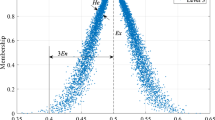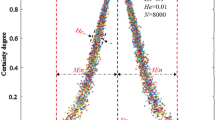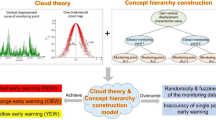Abstract
To address the uncertainty problem in the assessment of the overall safety trend of dams and in the selection of safety trend warning indicators, an Extended Cloud Model (ECM) combined with the Extended Analytic Hierarchy Process (EAHP) method is proposed in this study. In this new approach, different factors reflecting dam safety monitoring have been considered as a fuzzy system. Considering the characteristics of the forward cloud model and the backward cloud model, the original data have been extended to classify the division interval and determine the respective indicators. The weight distribution for each indicator level has been determined using the EAHP method. The model developed was applied to evaluate the safety trend of the Jilintai concrete panel rockfill dam. Simulation results showed that the proposed model can generate reliable results, in addition to being used to assess the uncertainty problem and the safety warning indicator. The proposed model is also more flexible and easier to use than other methods.







Similar content being viewed by others
Availability of Data and Materials
Availability of data and materials: all data and materials are available upon the requirement.
Change history
05 November 2022
A Correction to this paper has been published: https://doi.org/10.1007/s11269-022-03364-1
References
Araujo JC, Dias FF (2021) Multicriterial method of AHP analysis for the identification of coastal vulnerability regarding the rise of sea level: case study in Ilha Grande Bay, Rio de- Janeiro, Brazil. Nat Hazards 107:53–72
Dong W, Zhang S, Zhu F (2021) Evaluation of road performance of asphalt mixtures based on topological hierarchical analysis. J Jilin Univ (Eng Ed) 6:2137–2143
Fan J, Yang M, Liu BR, Wang JL, Gao JR, Su HZ, Zhao EF (2017) A comprehensive evaluation method study for dam safety. Struct Eng Mech 63(5):639–646
Gu YC, Wang SJ, Pang Q, Wang Y, Wu YX (2017) Research on the formulation of early warning indicators for concrete dam deformation based on risk management. J Hydraul Eng 48(04):480–487
Gu H, Yang M, Gu Ch, Zheng F, Xiaofei H (2022) A comprehensive evaluation method for concrete dam health state combined with gray-analytic hierarchy-optimization theory. Struct Health Monit 21(2):250–263
He J, Gao Q, Shi Y (2016) A multi-level comprehensive evaluation method for dam safety based on cloud model. Syst Eng Theory Pract 36(11):2977–2983
He J, Gao Q (2018) An improved cloud merging algorithm adapted to dam health diagnosis. J Wuhan Univ (Inf Sci Ed) 43(07):1022–1029
He GJ, Chai JR, Qin Y, Xu ZG, Li SY (2020) Coupled model of variable fuzzy sets and the analytic hierarchy process and its application to the social and environmental impact evaluation of dam breaks. Water Resour Manag 34:2677–2697
Ho JY, Ooi J, Wan YK, Andiappan V (2021) Synthesis of wastewater treatment process (WWTP) and supplier selection via fuzzy analytic hierarchy process (FAHP). J Clean Prod
Jafary P, Sarab AA, Tehrani NA (2018) Ecosystem health assessment using a fuzzy spatial decision support system in taleghan watershed before and after dam construction. Environ Process 5(4):807–831
Li DY, Meng H, Shi X (1995) Membership clouds and membership cloud generators. J Comput Res Dev 32(6):15–20
Li J, Wang M, Xu P, Xu P (2014) Classification of surrounding rock stability based on cloud mode. J Geotech Eng 36(01):83–87
Li X, Zhong D, Ren B, Deng S, Zhu Y (2017) Research on the evaluation of the irrigability of dam foundation rock based on fuzzy RES-cloud model. J Hydraul Eng 48(11):1311–1323
Li S, Cheng R, Chen Z, Zeng M, Hao J (2010) Analysis of seepage observation data of Jilintai I hydropower station dam. Water Resour Hydropower Eng 41(06):66–67
Lei P, Chang XL, Xiao F, Zhang GJ, Su HZ (2011) Study on early warning index of spatial deformation for high concrete dam. Sci China Ser E 54(6):1607–1614
Liu Z, Shao J, Xu W, Xu F (2014) Comprehensive stability evaluation of rock slope using the cloud model-based approach. Rock Mech Rock Eng 47(6):2239–2252
Nouha N, Ben AR, Habib A (2021) Water erosion hazard mapping using analytic hierarchy process (AHP) and fuzzy logic modeling: a case study of the Chaffar Watershed (Southeastern Tunisia). Arab J Geosci 14(13):1208
Peng T, Deng H (2020) Comprehensive evaluation on water resource carrying capacity in karst areas using cloud model with combination weighting method: a case study of Guiyang, southwest China. Environ Sci Pollut Res 27:37057–37073
Radhika EG, Sadasivam GS (2021) Budget optimized dynamic virtual machine provisioning in hybrid cloud using fuzzy analytic hierarchy process. Expert Syst Appl 183
Saaty TL, Zhang L (2016) The need for adding judgment in bayesian prediction. Int J Inf Technol Decis Mak 15(4):733–761
Su HZ, Hu J, Wu ZR (2012) A study of safety evaluation and early-warning method for dam global behavior. Struct Health Monit 11(3):269–279
Su H, Yan X, Liu H, Wen Z (2017) Integrated multi-level control value and variation trend early-warning approach for deformation safety of arch dam. Water Resour Manag 31(6):2025–2045
Wen YS, Liao J (2004) Formulation and performance of panel concrete for Jilintai I hydropower station. Water Resour Hydropower Eng 6:58–60
Wu Y, Chu H, Xu C (2021) Risk assessment of wind-photovoltaic-hydrogen storage projects using an improved fuzzy synthetic evaluation approach based on cloud model: A case study in China. J Energy Storage 38:10258
Wu ZR, Lu Y (1989) Safety monitoring indicators of dams using prototype observation feedback. J Hohai Univ 6:29–36
Wu ZR, Su HZ (2005) Dam health diagnosis and evaluation. Smart Mater Struct 14(3):S130–S136
Wu ZR, Peng Y, Li ZC, Li B, Yu H, Zheng SR (2011) Commentary of research situation and innovation frontier in hydro-structure engineering science. Sci China Ser E 54(4):767–780
Yan F, Zhang Q, Ye S, Ren B (2019) A novel hybrid approach for landslide susceptibility mapping integrating analytical hierarchy process and normalized frequency ratio methods with the cloud model. Geomorphology 327:170–187
Yan F, Xu K (2019) Methodology and case study of quantitative preliminary hazard analysis based on cloud model. J Loss Prev Process Ind 60:116–124
Yang G, Guo X, Gao W, Ma Y (2010a) Safety monitoring design of concrete panel gravel dams in Jilintai Grade I hydropower station. Water Resour Hydropower Technol 41(06):28–30
Yang R, Qing SF, Zeng MQ, Hao JS (2010b) Analysis of deformation monitoring data of concrete panel rockfill dam at Jilintai I hydropower station. Water Resour Hydropower Eng 41(06):61–65+75
Yang Y, Liu XL, Wang EZ, Fang K, Huang L (2018) Dam safety evaluation based on multiple linear regression and numerical simulation. Rock Mech Rock Eng 51(8):2451–2467
Zhang Q, Zhang Y, Zhong M (2014) Multi-level fuzzy integrated evaluation of reservoir-induced earthquake risk based on cloud model. J Hydraul Eng 45(01):87–95
Acknowledgements
This research is supported by the National Natural Science Foundation of China (Grant Nos. 51879065), National Energy Group Science and Technology Innovation Project of China (Grant Nos. GJNY-19-13), National Energy Group Xinjiang Jilintai Hydropower Development Co., The authors are grateful for the financial support.
Funding
This research is supported by the National Natural Science Foundation of China (Grant Nos. 51879065), National Energy Group Science and Technology Innovation Project of China (Grant Nos. GJNY-19–13), National Energy Group Xinjiang Jilintai Hydropower Development Co., The authors are grateful for the financial supports.
Author information
Authors and Affiliations
Contributions
All authors contributed to this research work. Here are contributions of each author: Conceptualization: L. Sang, J. Wang, J. Sui, and M. Dziedzic; Methodology: L. Sang, J. Wang, and J. Sui; Validation: L. Sang, J. Wang, and J. Sui; Formal analysis: L.Sang and J.Wang; Investigation: L. Sang, J. Wang, and J. Sui; Resources: L. Sang, J. Wang, and J. Sui; Writing-original draft preparation: L. Sang, J. Wang, and J. Sui; Writing-review and editing: J. Sui, and M. Dziedzic; Supervision: J. Wang, and J. Sui; Funding acquisition: J.Wang. All authors have read and agreed to the published version of the manuscript.
Corresponding author
Ethics declarations
Human and Animal Rights and Informed Consent
The study does not involve the use of humans or animals.
Financial Interests
The authors have no relevant financial or non-financial interests to disclose.
Competing Interests
The authors have no competing interests to declare that are relevant to the content of this article.
Conflict of Interest
All authors certify that they have no affiliations with or involvement in any organization or entity with any financial interest or non-financial interest in the subject matter or materials discussed in this manuscript.The authors have no financial or proprietary interests in any material discussed in this article. This manuscript is an original research work. This manuscript has never been submitted to other journals and conferences for possible publication. There is not any interest that is directly or indirectly related to this research work. There is not any potential conflict of interest.
Additional information
Publisher's Note
Springer Nature remains neutral with regard to jurisdictional claims in published maps and institutional affiliations.
The original online version of this article was revised: The 2nd author's name should be "Jun Wang" (Not Jun C Wang). And the bottom of 1st page, address 2 must be corrected as "School of Engineering, University of Northern British Columbia, Prince George, CANADA" (Not China).
Rights and permissions
About this article
Cite this article
Sang, L., Wang, J., Sui, J. et al. A New Approach for Dam Safety Assessment Using the Extended Cloud Model. Water Resour Manage 36, 5785–5798 (2022). https://doi.org/10.1007/s11269-022-03124-1
Received:
Accepted:
Published:
Issue Date:
DOI: https://doi.org/10.1007/s11269-022-03124-1




